While the news is unpredictable, news partnerships don’t have to be. John Bebow, publisher of Bridge Magazine, said there haven’t been any knotty moments in his partnership with Crain’s Detroit Business.
“I know this sounds like sunny bullshit,” he said. “Part of the reason is, we sat down and negotiated every last detail.”
That was wise, given the nature of the deal: a shared business reporter in the state capital. They had many conversations about issues such as whom the reporter would answer to and whose payroll she would be on. They developed a job description together and agreed on whom to hire.
“That setup work is really important. It’s so much more important to do this up front well, rather than quickly,” Bebow said.
At The Marshall Project, managing editor Kirsten Danis learned a lesson about prep work after a newspaper partnership broke down. “We never sat down with them, although this newspaper was not far away from us. We could’ve done it,” she said. If she could do it over, Danis said would have met with everyone first and reassigned the project when relationships became rocky.
It’s not always obvious when a collaboration is failing. One sign is when you see pushback from people whose support is needed, such as editors or even the reporters themselves. They may ask questions about the direction of the story or who’s making decisions. Other times, problems stem from a mismatch of priorities: One newsroom is very focused on the project, but it’s on the back burner at the other.
You can head off many problems with good planning. Here are some questions you should address. Put the answers in writing.
1. Roles and responsibilities
On the editorial side:
Who is responsible for the reporting, the writing and the editing? If there are disagreements, who makes the final decision? How will people share their work with others?
How will the partners decide which stories and topics to pursue? Who will participate in editorial meetings?
How will the editing work? How much time does everyone have to review drafts or rough cuts? Will one organization’s style guide prevail?
What are the interim deadlines for the project? What’s the target publication date? Is it flexible? What happens if you change it?
When the partners are on different platforms: Will a print or digital reporter hand off interviews to a reporter or producer at a television station, or will they conduct interviews jointly? Which interviews need to be on tape for a radio partnership, and how will they be handled?
Jeff Woodard, the WGRZ-TV news director who set up its partnership with Investigative Post in Buffalo, said the nonprofit’s staff didn’t have any experience shooting or editing video when they started. WGRZ had to work with them on writing for television, too.
On the business side:
If money has to be raised for the partnership, who will raise it? If the nonprofit embarks on a crowdfunding campaign, will the commercial partner support it with staff time, marketing or a contribution? If two outlets share a staffer, whose payroll will the reporter be on?
Who will make sure non-editorial support is provided, if that is part of the agreement? For example, who controls access to facilities? Who will create promotional material such as teasers and house ads?
2. Chain of command
The chain of command in partnerships depends on the circumstances and people involved.
One model is to put a single person in charge. If you do that, make it perfectly clear, said Ken Foskett, senior editor for investigations at The Atlanta Journal-Constitution, at the Investigative Reporters & Editors conference last year.
“My own personal philosophy,” he said, “is you should really try to make decisions as collaboratively as possible with the team that you have. But everybody also needs to understand that there is one person that gets to make the final decision.”
Another model is to give each partner veto power over what gets published or broadcast on its platforms and social channels. That’s how it works in Buffalo between Investigative Post and WGRZ.
The content belongs to Investigative Post, Woodard said. But the TV station “had the right — we never used this while I was there — to kill that and not put it on air.”
The other key person to identify is the project manager, who is usually different from the person who sets the editorial direction. The project manager on a partnership watches deadlines, manages communications and makes sure everything runs smoothly.
“I kept track of what the different partners were doing, whether or not we’d talked to particular sources,” said Lee van der Voo of InvestigateWest, who managed a collaboration over the last year with Pamplin Media Group, a newspaper publisher in Oregon. “I was manning the relationships, setting up the meetings, writing the [agreements] for all the partners,” she said.
Sometimes the project manager will have a counterpart or a point of contact at the partner organization. A nonprofit newsroom with a track record of partnerships often has experienced staff who can manage the project for both organizations. Some, like The Marshall Project and inewsource, have a team member dedicated to ensuring partnerships succeed.
3. Money
Has someone estimated how much the project will cost, and have both sides signed off on it? What will happen if costs exceed expectations or the scope changes? Is there a maximum commitment?
If money is changing hands, when will that happen? Who will pay the writer and photographer? What about travel expenses? Infographics or digital features?
If one side is providing in-kind support, how much is it valued? When will it be made available?
4. Copyright
Who owns the copyright to the content? What rights does each partner have to it? Do you need to account for obligations to third parties, such as exclusive distribution agreements?
Nonprofits typically will want to secure the right to publish jointly produced stories, photographs and other material on their site and in the future. Oftentimes they will use portions of these stories in fundraising and marketing, so that may need to be addressed up front.
The nonprofit ProPublica licenses most of its stories under Creative Commons for others to freely distribute, but retains some pieces as exclusives for its commercial partners.
InvestigateWest hung posters of front-page stories at its live events, and its fundraising brochures featured photography from major stories. The Food & Environment Reporting Network (also known as FERN) published an anthology with sixteen of its best stories from 2011 to 2016, which would’ve been harder to do if it hadn’t negotiated all along for that right.
These issues aren’t addressed in a standard freelance contract that treats a story as a “work for hire.” You need an agreement that allows each partner to retain ownership of original work and licenses publication and usage rights for jointly created work.
“When you’re writing a contract, the lawyers don’t always get that,” said Sam Fromartz of FERN. “We’re ready to walk on that issue.”
5. Marketing and branding
Decide how you will market the partnership. Does it require its own branding and logo, and if so, who will handle that? Will one partner take the lead on marketing or will each handle it independently?
One key consideration is how each side will be credited. Don’t wait until you’re ready to publish before you decide this.
“We want some recognition in terms of credit with the story, so that it’s described as a collaboration of FERN and whatever media company it is,” Fromartz said.
You can avoid an oversight on deadline if you share something in writing with TV producers, the social media team, on-air talent, page designers, and web producers — particularly if weeks or months have passed since the initial agreement.
These questions are all the more important because commercial partners usually have greater name recognition than the nonprofit. Jim Heaney of Investigative Post said TV viewers often think he works in WGRZ’s newsroom. That happens even though the station identifies Heaney and other Investigative Post journalists with lower-thirds and the nonprofit’s logo whenever they are on air.
Best practices for partnership agreements
Here are a few actual agreements that show how partnerships are negotiated and formalized.
Charlottesville Tomorrow and The Daily Progress
The contract between these two Virginia publishers spells out several deals: an editorial collaboration, advertising, printing and distribution of an annual report, and biannual local election coverage.
Advertising and marketing:
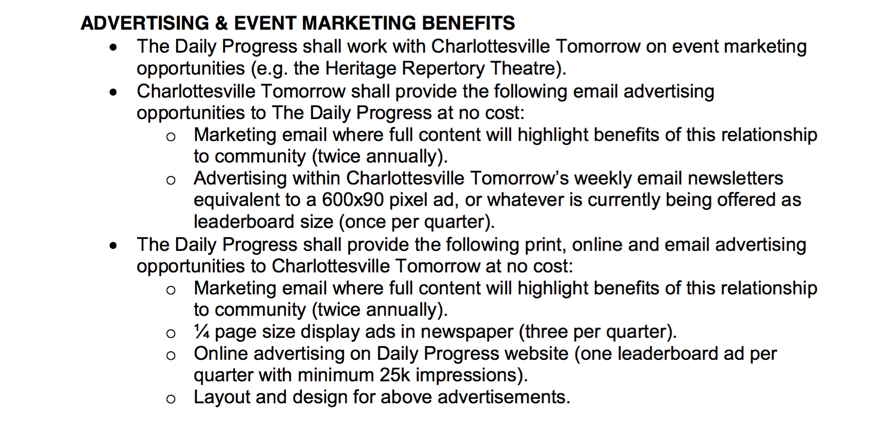
Annual report:

Election coverage:

Bridge Magazine and Crain’s Detroit Business
This contract covers intellectual property rights as well as a number of other topics:
- The reporter would be jointly interviewed and hired.
- The reporter would be employed by Bridge but would report to Crain’s. Major projects would be jointly planned by the reporter, Crain’s and Bridge.
- Crain’s would pay half the cost for the shared reporter, in quarterly payments.
- The reporter would work in the Bridge office in Lansing but do orientation in the Crain’s newsroom and work one or two days a month at its office in Detroit.
- Crain’s editors would set performance goals, such as a weekly print column and a certain number of breaking news stories.
- It included details about how and when stories would be posted on each partner’s site.
InvestigateWest
InvestigateWest’s contracts weren’t as extensive because most of its partnerships dealt with individual stories. A typical contract, such as one with the KING 5 television station in Seattle, addressed the scope of work, ownership, credit, publicity and payment:
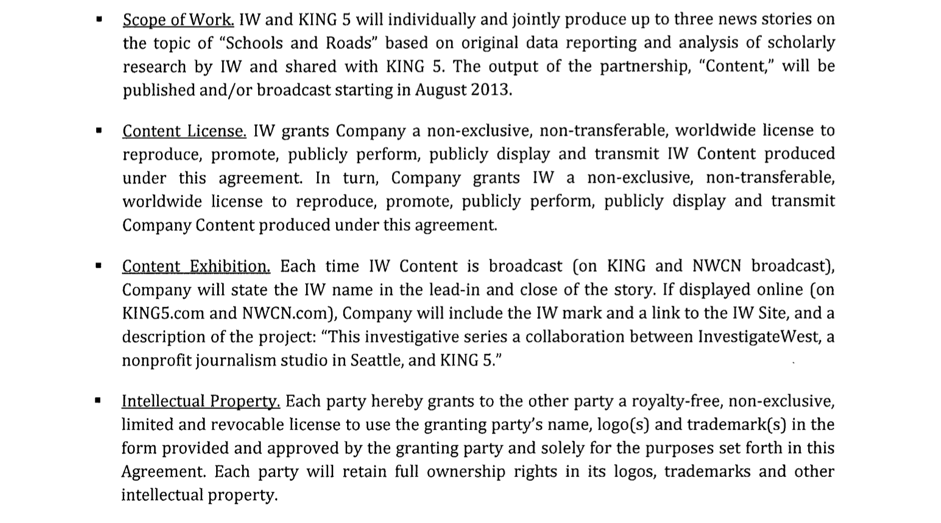
Institute for Nonprofit News
INN offers a standard publication agreement that its members can use in drafting their own. The INN agreement spells out publication date, contractual limits on third-party edits, licensing fees and the scope of publication rights.
Food & Environment Reporting Network
FERN’s standard contract offers limited exclusivity to its partners (typically 30 days), during which the story can appear only on the partner and FERN’s sites. After that, publication rights are nonexclusive.
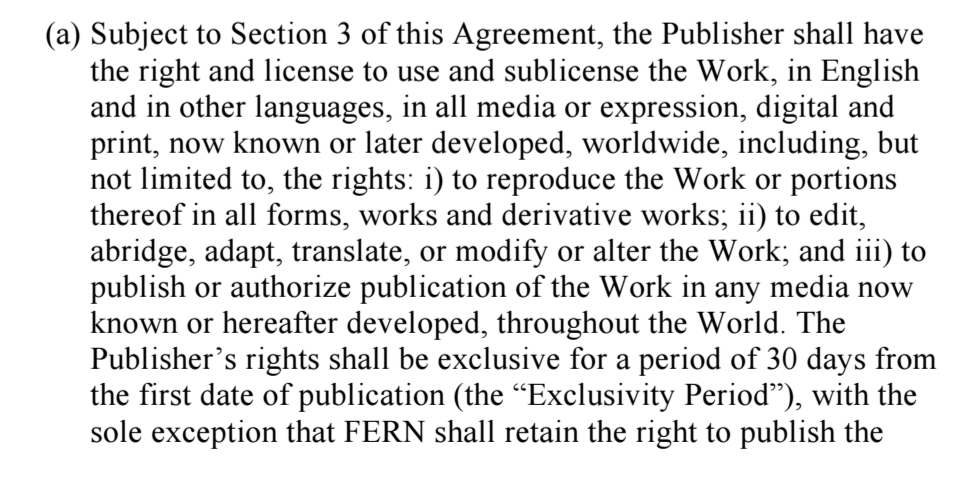
The contract also lays out basic expectations about marketing and promotion of the story, as well as the author’s media appearances, so FERN can track their impact and derive some benefit from them.
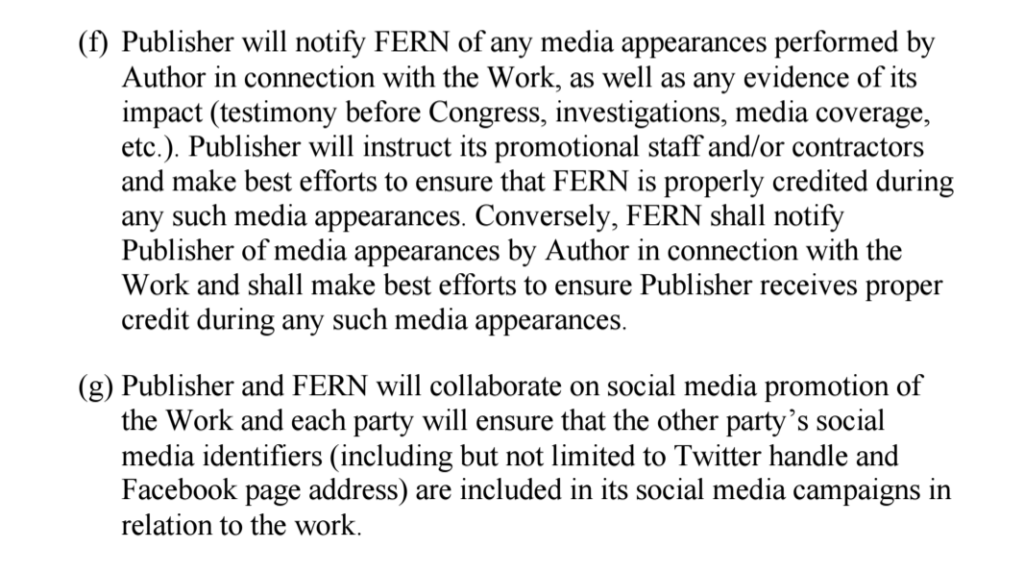
The contract describes the process for pre-publication editorial review and approval and what happens if there’s an intractable disagreement.
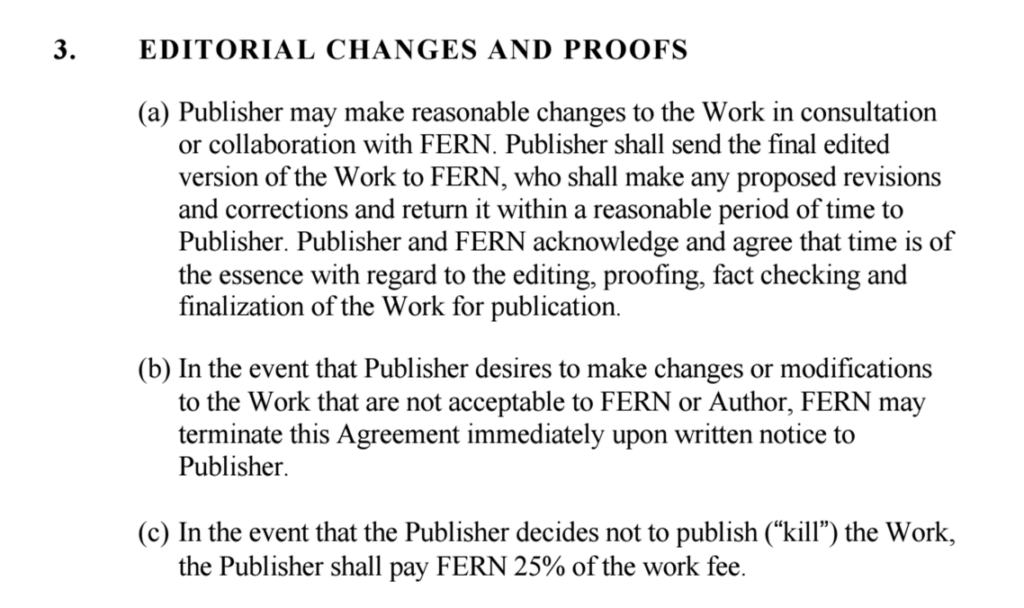
Do you need a lawyer?
The short answer: It depends.
The longer, more lawyerly answer: Your individual circumstances and the scope of the partnership will determine whether you need to bring in a lawyer to draft your partnership agreement.
The partnerships in this report represent a mix of contractual and informal arrangements. For a partnership involving a single story or project, an agreement by email often suffices.
The stakes are higher in long-term partnerships, so it’s helpful to have lawyers review or draft a contract. Lawyers should get involved for agreements that involve a substantial amount of money or a joint hire.
If you’re a nonprofit and you don’t have a lawyer on retainer, local law firms sometimes will provide pro bono services. The Institute for Nonprofit News has a page with legal resources.
Getting the right level of detail in an agreement
How much detail do you really need? Here’s are best practices based on our research.
Lay out your plans in an email if:
- It’s a one-off collaboration.
- It is just a distribution deal.
- You’ve worked with the organization before.
- There’s just one editor involved on each side.
- There’s just one reporter involved.
A letter of agreement is good for key details if:
- There will be reporting expenses.
- Stories will run in more than one format.
- You’ve worked together before, but it could it have gone better.
- Money is changing hands.
- More than one reporter is involved, or more than one editor is involved on each side.
A contract sounds like a good idea if:
- A lot of money is changing hands.
- There are a lot of reporting expenses.
- There is legal risk with the story.
- You’ll be sharing an employee.
Share with your network
- Key issues to discuss before you embark on a news partnership
- Nurturing a partnership
- Partnerships are business deals, but they’re not always about cash
- 4 practical steps to forming news partnerships
- How news partnerships work: Commercial and nonprofit newsrooms can work together to benefit and change journalism
You also might be interested in:
Successfully and efficiently marketing your work can be hard, especially for local news teams with limited resources, but marketing yourself to your audience is an essential skill for news organizations to drive revenue and promote sustainability.
As news teams begin thinking about their election coverage plans, it may feel like adding more tasks to an already full plate, with a fraction of the staff and resources they once had. But that doesn’t have to mean figuring out how to do more with less — maybe it’s doing less with less.
We reached out to Danielle Coffey, the CEO of American Press Institute’s parent corporation, the News/Media Alliance, to learn more about the legal fight for news organizations’ rights with AI.


